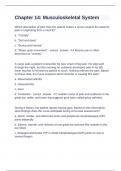Exam (elaborations)
Chapter 17 Question and answers already passed
- Course
- Institution
Chapter 17 Question and answers already passed Which description of pain from the patient makes a nurse suspect the patient's pain is originating from a muscle? a. "Crampy" b. "Dull and deep" c. "Boring and intense" d. "Sharp upon movement" - correct answer A Muscle pain is often described a...
[Show more]



